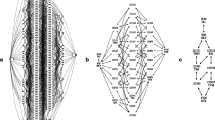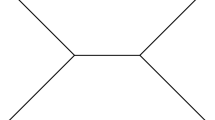Summary
In the maximum likelihood (ML) method for estimating a molecular phylogenetic tree, the pattern of nucleotide substitutions for computing likelihood values is assumed to be simpler than that of the actual evolutionary process, simply because the process, considered to be quite devious, is unknown. The problem, however, is that there has been no guarantee to endorse the simplification.
To study this problem, we first evaluated the robustness of the ML method in the estimation of molecular trees against different nucleotide substitution patterns, including Jukes and Cantor's, the simplest ever proposed. Namely, we conducted computer simulations in which we could set up various evolutionary models of a hypothetical gene, and define a true tree to which an estimated tree by the ML method was to be compared. The results show that topology estimation by the ML method is considerably robust against different ratios of transitions to transversions and different GC contents, but branch length estimation is not so. The ML tree estimation based on Jukes and Cantor's model is also revealed to be resistant to GC content, but rather sensitive to the ratio of transitions to transversions.
We then applied the ML method with different substitution patterns to nucleotide sequence data ontax gene from T-cell leukemia viruses whose evolutionary process must have been more complicated than that of the hypothetical gene. The results are in accordance with those from the simulation study, showing that Jukes and Cantor's model is as useful as a more complicated one for making inferences about molecular phylogeny of the viruses.
Similar content being viewed by others
References
Bernardi G, Mouchiroud D, Gautier C, Berenardi G (1988) Compositional patterns in vertebrate genomes: conservation and change in evolution. J Mol Evol 28:7–18.
Brown WM, Prager EM, Wang A, Wilson AC (1982) Mitochondrial DNA sequences of primates-tempo and mode of evolution. J Mol Evol 18:225–239
Felsenstein J (1981) Evolutionary trees from DNA sequences: a maximum likelihood approach. J Mol Evol 17:368–376
Fukami K, Tateno Y (1989) On the maximum likelihood method for estimating molecular trees: uniqueness of the likelihood point. J Mol Evol 28:460–464
Gallo RC, Wong-Staal F, Montagnier L, Haseltine WA, Yoshida M (1988) HIV/HTLV gene nomenclature. Nature 339:504
Gojobori T, Li W-H, Graur D (1982) Patterns of nucleotide substitution in pseudogenes and functional genes. J Mol Evol 18:360–369
Hasegawa M, Kishino H (1989) Confidence limits on the maximum likelihood estimate of the hominoid tree from mitochondrial DNA sequences. Evolution 43:672–677
Hasegawa M, Kishino H, Yano T (1988) Phylogenetic inference from DNA sequence data. In: Matusita K (ed) Statistical theory and data analysis II. North-Holland, Amsterdam, pp 1–13
Haseltine WA, Sodroski JG, Patarca R (1985) Structure and function of the genome of HTLV. In: Vogt PK (ed) Human T-cell leukemia virus. Springer-Verlag, Berlin, pp 177–210
Hixson JE, Brown WM (1986) A comparison of the small ribosomal RNA genes from the mitochondrial DNA of the great apes and humans: sequence, structure, evolution and phylogenetic implications. Mol Biol Evol 3:1–18
Ikemura T, Aota S (1988) Global variation in G+C content along vertebrate genome DNA. Possible correlation with chromosome band structures. J Mol Biol 203:1–13
Ina Y, Gojobori T (1990) Molecular evolution of human T-cell leukemia viruses. J Mol Evol (in press)
Jukes TH, Cantor CR (1969) Evolution of protein molecules. In: Munro HN (ed) Mammalian protein metabolism. Academic, New York, pp 21–132
Kimura M (1980) A simple method for estimating evolutionary rates of base substitutions through comparative studies of nucleotide sequences. J Mol Evol 16:111–120
Kishino H, Hasegawa M (1989) Evaluation of the maximum likelihood estimate of the evolutionary tree topologies from DNA sequence data, and the branching order in Hominoidea. J Mol Evol 29:170–179
Kishino H, Hasegawa M (1990) Converting distance to time: an application to human evolution. In: Doolittle RF (ed) Methods in enzymology, vol 183. North-Holland, New York pp 550–570
Li W-H, Wu C-I, Luo C-C (1984) Nonrandomness of point mutation as reflected in nucleotide substitutions in pseudogenes and its evolutionary implications. J Mol Evol 21:58–71
Miyata T, Yasunaga T, Nishida T (1980) Nucleotide sequence divergence and functional constraint in mRNA evolution. Proc Natl Acad Sci USA 77:7328–7332
Nei M (1975) Molecular population genetics and evolution. North-Holland, Amsterdam
Nei M (1987) Molecular evolutionary genetics. Columbia University Press, New York
Orito E, Mizokami M, Ina Y, Moriyama EN, Kameshima N, Yamamoto M, Gojobori T (1989) Host-independent evolution and a genetic classification of the hepadnavirus family based on nucleotide sequences. Proc Natl Acad Sci USA 86:7059–7062
Ratner L, Josephs SF, Starcich B, Hahn B, Shaw GM, Gallo RC, Wong-Staal F (1985) Nucleotide sequence analysis of a variant human T-cell leukemia virus (HTLV-Ib) provirus with a deletion in pX-I. J Virol 54:781–790
Rice NR, Stephens RM, Couez D, Deschamps J, Kettmann R, Burny A, Gilden RV (1984) The nucleotide sequence of theenv gene and post-env region of bovine leukemia virus. Virology 138:82–93
Robinson DF, Foulds LR (1981) Comparison of phylogenetic trees. Math Biosci 53:131–147
Sagata N, Yasunaga T, Tsuzuku-Kawamura J, Ohishi K, Ogawa Y, Ikawa Y (1985) Complete nucleotide sequence of the genome of bovine leukemia virus: its evolutionary relationship to other retroviruses. Proc Natl Acad Sci USA 82:677–681
Saitou N (1988) Property and efficiency of the maximum likelihood method for molecular phylogeny. J Mol Evol 27:261–273
Saitou N, Imanishi T (1989) Relative efficiencies of the Fitch-Margoliash, maximum-parsimony, maximum-likelihood, minimum-evolution, and neighbor-joining methods of phylogenetic tree construction in obtaining the correct tree. Mol Biol Evol 6:514–525
Saitou N, Nei M (1987) The neighbor-joining method: a new method for reconstructing phylogenetic trees. Mol Biol Evol 4:406–425
Seiki M, Hattori S, Hirayama Y, Yoshida M (1983) Human adult T-cell leukemia virus: complete nucleotide sequence of the provirus genome integrated in leukemia cell DNA. Proc Natl Acad Sci USA 80:3618–3622
Shimotohno K, Takahashi Y, Shimizu N, Gojobori T, Golde D, Chen ISY, Miwa M, Sugimura T (1985) Complete nucleotide sequence of an infectious clone of human T-cell leukemia virus type II: an open reading frame for the protease gene. Proc Natl Acad Sci USA 82:3101–3105
Sneath PHA, Sokal RR (1973) Numerical taxonomy. Freeman, San Francisco
Soeda E, Maruyama T (1980) Host-dependent evolution of three papova viruses. Nature 285:165–167
Sokal RR, Sneath PHA (1963) Principles of numerical taxonomy. Freeman, San Francisco
Sueoka N (1961) Variation and heterogeneity of base composition of deoxyribonucleic acids: a compilation of old and new data. J Mol Biol 3:31–40
Tajima F, Nei M (1984) Estimation of evolutionary distance between nucleotide sequences. Mol Biol Evol 1:269–285
Tateno Y, Nei M, Tajima F (1982) Accuracy of estimated phylogenetic tree from molecular data I. Distantly related species. J Mol Evol 18:387–404
Yokoyama S, Gojobori T (1987) Molecular evolution and phylogeny of the human AIDS viruses LAV, HTLV-III, and ARV. J Mol Evol 24:330–336
Yoshida M, Hattori S, Seiki M (1985) Molecular biology of human T-cell leukemia virus associated with adult T-cell leukemia. In: Vogt PK (ed) Human T-cell leukemia virus. Springer-Verlag, Berlin, pp 157–176
Watanabe T, Seiki M, Tsujimoto H, Miyoshi I, Hayami M, Yoshida M (1985) Sequence homology of the simian retrovirus genome with human T-cell leukemia virus type I. Virology 144:59–65.
Author information
Authors and Affiliations
Rights and permissions
About this article
Cite this article
Fukami-Kobayashi, K., Tateno, Y. Robustness of maximum likelihood tree estimation against different patterns of base substitutions. J Mol Evol 32, 79–91 (1991). https://doi.org/10.1007/BF02099932
Received:
Revised:
Issue Date:
DOI: https://doi.org/10.1007/BF02099932




